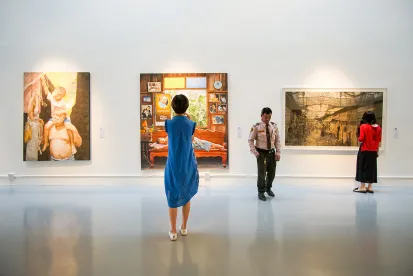The National Defense Authorization Act for Fiscal Year 2021 (“NDAA”) became law early in 2021, after a congressional override of then-President Trump’s veto. Division F of the NDAA consists of the Anti-Money Laundering Act of 2020 (“AMLA”). The AMLA expands numerous Bank Secrecy Act (“BSA”) requirements, and amends the BSA’s definition of “financial institution” to include persons “engaged in the trade of antiquities.”[1] Section 6110(c) of the AMLA also requires the Secretary of the Treasury, in coordination with the Director of the Federal Bureau of Investigation, the Attorney General, and the Secretary of Homeland Security, to perform a study of the facilitation of money laundering and the financing of terrorism (“ML/TF”) through the trade in works of art. The Department of the Treasury released its report in February 2022, containing the findings and determinations made in carrying out the required study.
-
Scope of the Study
The study focuses on high-value art, such as paintings, drawings, and sculptures that are sold in traditional, in-person art market venues, or online through certain marketplaces, and digital art sold through internet marketplaces.
The study evaluates the extent to which this type of high-value art is susceptible to ML/TF by illicit actors.
-
Current Regulatory Framework
Though they are not subject to AML/CFT obligations, participants in the U.S. art market are subject to certain general reporting requirements.
First, art industry participants that are not financial institutions are required to report large currency and monetary instrument transactions.
Second, all U.S. persons must comply with Office of Foreign Assets Control (“OFAC”) regulations. OFAC defines U.S. persons to include all U.S. citizens and lawful permanent residents regardless of where they are located, all individuals and entities within the United States, and all U.S. incorporated entities and their foreign branches. While OFAC generally exempts transactions related to sanctioned countries that involve “the importation from any country, or the exportation to any country…of any information or informational materials, including but not limited to…artworks,”[2] the agency does not interpret this exemption to allow blocked persons or their facilitators to evade sanctions by exchanging financial assets for high-value artwork or vice versa.[3] Further, OFAC has stated it will apply its sanctions to transactions involving artworks in which a blocked person has an interest, to the extent the artwork functions primarily as an investment asset or medium of exchange.[4]
The study revealed that most art market participants are not mandated by federal regulations to maintain AML/CFT programs. Nevertheless, many maintain voluntary programs that include procedures for collecting information on customers. Though not legally mandated, adoption of these voluntary programs appears to be a best practice in the industry for high-value art. However, the lack of regulatory requirements for such programs also means that government authorities cannot take administrative or enforcement actions when such programs are ineffective or nonexistent.
While some art market participants may provide information in response to informal law enforcement requests, this is at the discretion of individual art market participants. There may be few other legal mechanisms for obtaining customer information other than a subpoena or court order. Based on these facts and the evidence presented throughout the rest of the study, Treasury concluded that there is some evidence of ML risk in the high-value art market and little evidence of TF risk.
-
Vulnerabilities of the Art Market
Several factors attract illicit actors to the art market. Specifically, the high-dollar values of single transactions, the ease of transporting works of art, the long-standing culture of privacy in the market including private sales and transactions where prices are subjective or can be manipulated, and the increasing use of art as an investment or financial asset all contribute to the ML vulnerabilities of art.
-
Recommendations
The study provides recommendations to stem illicit actors’ abuse of the art market. For example, Treasury should consider encouraging the creation and enhancement of private-sector information-sharing programs to foster transparency among art market participants and updating guidance and training for law enforcement, customs enforcement, and asset recovery agencies. From a regulatory perspective, Treasury should consider (i) using FinCEN recordkeeping authorities to support information collection and enhanced due diligence; and (ii) obligating certain art market participants to create and maintain AML/CFT programs.
The study also addresses whether AML/CFT requirements should be applied to the high-value art market. While the study acknowledges that high-value art and the market in which it is traded can be abused to launder funds, it concludes that any imposition of additional regulatory obligations on the sector should be made while considering other gaps and vulnerabilities in the U.S. AML/CFT regime that Treasury has already prioritized (such as high-risk real estate transactions). The study recommends that Treasury first complete any ongoing work to close outstanding gaps in the U.S. AML/CFT regime related to beneficial ownership, real estate, and potentially investment advisers and nonfinancial gatekeepers prior to potentially turning to the high-value art market.
ENDNOTES
[1] See Section 6110 of the AMLA. FinCEN has issued an Advance Notice of Proposed Rulemaking to solicit public comment on a range of questions related to the implementation of amendments to the BSA regarding the trade in antiquities. 86 Fed. Reg. 53,021 (Sept. 24, 2021).
[2] See 50 U.S.C. § 1702(b)(3); 50 U.S.C. § 4305(b)(4).
[3] See U.S. Department of the Treasury, “Advisory and Guidance on Potential Sanctions Risks Arising from Dealings in High-Value Artwork,” October 30, 2020, https://home.treasury.gov/system/files/126/ofac_art_advisory_10302020.pdf.
[4] Id.





 />i
/>i
